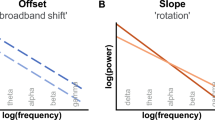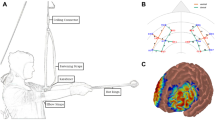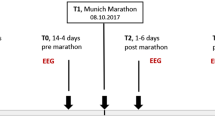Abstract
Long-duration exercise has been linked with the psychological model of flow. It is expected that the flow experience is characterized by specific changes in cortical activity, especially a transient hypofrontality, which has recently been connected with an increase in cognitive performance post-exercise. Nevertheless, data on neuro-affective and neuro-cognitive effects during prolonged exercise are rare. The cognitive performance, mental state, flow experience, and brain cortical activity of 11 ultramarathon runners (6 female, 5 male) were assessed before, several times during, and after a 6-h run. A decrease in cortical activity (beta activity) was measured in the frontal cortex, whereas no changes were measured for global beta, frontal or global alpha activity. Perceived physical relaxation and flow state increased significantly after 1 h of running but decreased during the following 5 h. Perceived physical state and motivational state remained stable during the first hour of running but then decreased significantly. Cognitive performance as well as the underlying neurophysiological events (recorded as event-related potentials) remained stable across the 6-h run. Despite the fact that women reported significant higher levels of flow, no further gender effects were noticeable. Supporting the theory of a transient hypofrontality, a clear decrease in frontal cortex activity was noticeable. Interestingly, this had no effect on cognitive performance. The fact that self-reported flow experience only increased during the first hour of running before decreasing, leads us to assume that changes in cortical activity, and the experience of flow may not be linked as previously supposed.



Similar content being viewed by others
References
Ashby FG, Casale MB (2002) The cognitive neuroscience of implicit category learning. In: Jiménez L (ed) Attention and implicit learning. John Benjamins Publishing Company, Amsterdam, Philadelphia, pp 109–141
Bachasson D, Temesi J, Gruet M, Yokoyama K, Rupp T, Millet GY, Verges S (2016) Transcranial magnetic stimulation intensity affects exercise-induced changes in corticomotoneuronal excitability and inhibition and voluntary activation. Neuroscience 314:125–133. doi:10.1016/j.neuroscience.2015.11.056
Brummer V, Schneider S, Struder HK, Askew CD (2011) Primary motor cortex activity is elevated with incremental exercise intensity. Neuroscience 181:150–162. doi:10.1016/j.neuroscience.2011.02.006
Csikszentmihalyi M (1990) Flow: the psychology of optimal experience. Harper and Row, New York
Csikszentmihalyi M, Rathunde K (1992) The measurement of flow in everyday life: toward a theory of emergent motivation. Nebr Symp Motiv 40:57–97
Dehaene S, Naccache L (2001) Towards a cognitive neuroscience of consciousness: basic evidence and a workspace framework. Cognition 79:1–37
Dietrich A (2003) Functional neuroanatomy of altered states of consciousness: the transient hypofrontality hypothesis. Conscious Cogn 12:231–256
Dietrich A (2004) Neurocognitive mechanisms underlying the experience of flow. Conscious Cogn 13:746–761
Dietrich A (2006) Transient hypofrontality as a mechanism for the psychological effects of exercise. Psychiatry Res 145:79–83. doi:10.1016/j.psychres.2005.07.033
Grego F, Vallier JM, Collardeau M, Rousseu C, Cremieux J, Brisswalter J (2005) Influence of exercise duration and hydration status on cognitive function during prolonged cycling exercise. Int J Sports Med 26:27–33. doi:10.1055/s-2004-817915
Jackson SA (1996) Toward a conceptual understanding of the flow experience in elite athletes. Res Q Exerc Sport 67:76–90
Jackson SA (1999) Joy, fun, and flow state in sport. In: Hanin Y (ed) Emotions in sport. Human Kinetics, Champaign, pp 135–155
Jackson SA, Marsh HW (1996) Development and validation of a scale to measure optimal experience: the flow state scale. J Sport Exerc Psychol 18:17–35
Jackson SA, Martin AJ, Eklund RC (2008) Long and short measures of flow: the construct validity of the FSS-2, DFS-2, and new brief counterparts. J Sport Exerc Psychol 30:561–587
Karageorghis CI, Jones L (2014) On the stability and relevance of the exercise heart rate— music-tempo preference relationship. Psychol Sport Exerc 15:299–310
Kleinert J (2006) Adjektivliste zur Erfassung der wahrgenommenen körperlichen Verfassung (WKV): skalenkonstruktion und erste psychometrische Befunde [Adjective list for assessing Perceived Physical State (PEPS). Scale construction and psychometric results]. Zeitschrift für Sportpsychologie 13:156–164
Martin AJ, Tipler DV, Marsh HW, Richards GE, Williams MR (2006) Assessing multidimensional physical activity motivation, assessing multidimensional physical activity motivation: a construct validity study of high-school students. J Sport Exerc Psychol 28:171–192
Miller EK, Cohen JD (2001) An integrative theory of prefrontal cortex function. Annu Rev Neurosci 24:167–202
Millet GY, Lepers R (2004) Alterations of neuromuscular function after prolonged running, cycling and skiing exercises. Sports Med 34:105–116
Moore RD, Romine MW, O’Connor PJ, Tomporowski PD (2012) The influence of exercise-induced fatigue on cognitive function. J Sports Sci 30:841–850. doi:10.1080/02640414.2012.675083
Omoto S, Kuroiwa Y, Otsuka S et al (2010) P1 and P2 components of human visual evoked potentials are modulated by depth perception of 3-dimensional images. Clin Neurophysiol 121:386–391. doi:10.1016/j.clinph.2009.12.005
Parker SM, Erin JR, Pryor RR et al (2013) The effect of prolonged light intensity exercise in the heat on executive function. Wilderness Environ Med 24:203–210. doi:10.1016/j.wem.2013.01.010
Roelands B, De Pauw K, Meeusen R (2015) Neurophysiological effects of exercise in the heat. Scand J Med Sci Sports 25(Suppl 1):65–78. doi:10.1111/sms.12350
Schneider S, Kleinert J, Steinbacher A, Brümmer V, Strüder HK (2008) The effect of parabolic flight on perceived physical, motivational and psychological state in men and women: correlation with neuroendocrine stress parameters and electrocortical activity. Stress 12:336–349
Schneider S, Askew CD, Diehl J et al (2009a) EEG activity and mood in health orientated runners after different exercise intensities. Physiol Behav 96:709–716. doi:10.1016/j.physbeh.2009.01.007
Schneider S, Brummer V, Abel T, Askew CD, Struder HK (2009b) Changes in brain cortical activity measured by EEG are related to individual exercise preferences. Physiol Behav 98:447–452. doi:10.1016/j.physbeh.2009.07.010
Schneider S, Vogt T, Frysch J, Guardiera P, Struder HK (2009c) School sport—a neurophysiological approach. Neurosci Lett 467:131–134. doi:10.1016/j.neulet.2009.10.022
Schneider S, Askew CD, Abel T, Mierau A, Struder HK (2010a) Brain and exercise: a first approach using electrotomography. Med Sci Sports Exerc 42:600–607. doi:10.1249/MSS.0b013e3181b76ac8
Schneider S, Brummer V, Carnahan H, Kleinert J, Piacentini MF, Meeusen R, Struder HK (2010b) Exercise as a countermeasure to psycho-physiological deconditioning during long-term confinement. Behav Brain Res 211:208–214. doi:10.1016/j.bbr.2010.03.034
Schneider S, Abeln V, Popova J, Fomina E, Jacubowski A, Meeusen R, Struder HK (2013) The influence of exercise on prefrontal cortex activity and cognitive performance during a simulated space flight to Mars (MARS500). Behav Brain Res 236:1–7. doi:10.1016/j.bbr.2012.08.022
Vogel EK, Luck SJ (2000) The visual N1 component as an index of a discrimination process. Psychophysiology 37:190–203. doi:10.1111/1469-8986.3720190
Author information
Authors and Affiliations
Corresponding author
Rights and permissions
About this article
Cite this article
Wollseiffen, P., Schneider, S., Martin, L.A. et al. The effect of 6 h of running on brain activity, mood, and cognitive performance. Exp Brain Res 234, 1829–1836 (2016). https://doi.org/10.1007/s00221-016-4587-7
Received:
Accepted:
Published:
Issue Date:
DOI: https://doi.org/10.1007/s00221-016-4587-7




